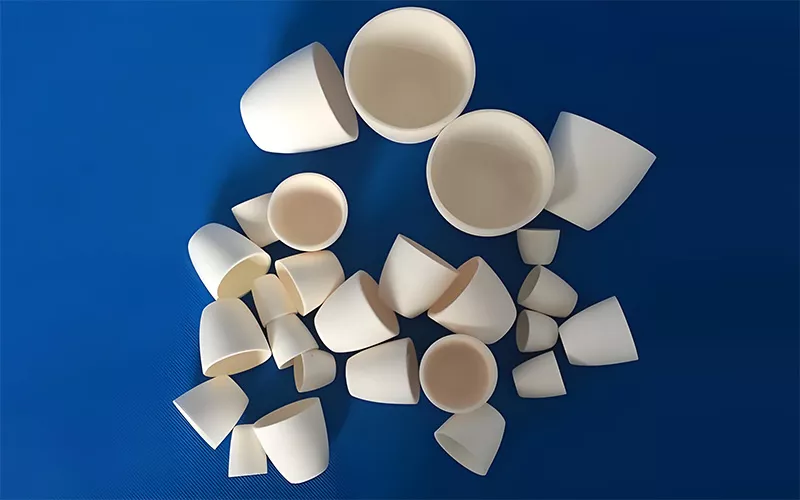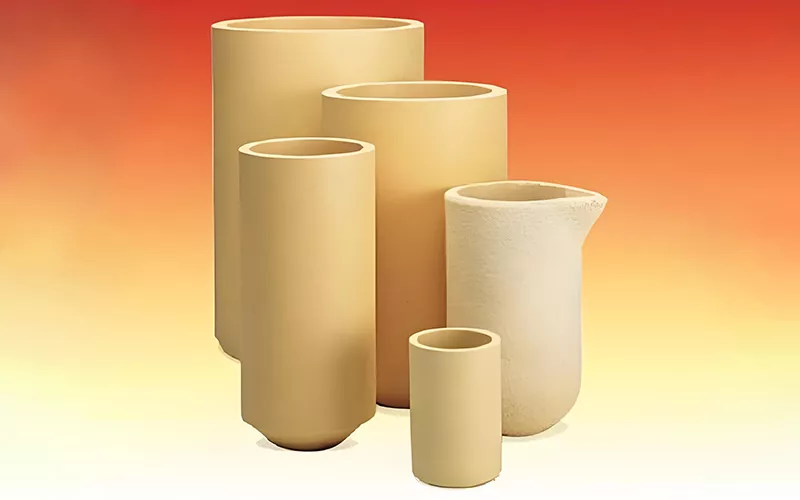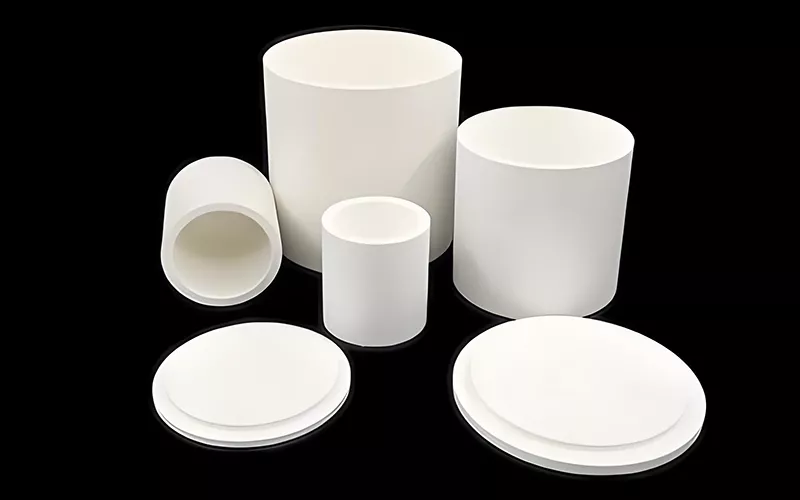Ceramic crucibles are containers with high melting points and high temperature resistance. They combine chemical stability with a low coefficient of thermal expansion, making them essential tools for extremely high-temperature applications in laboratories, metallurgy, semiconductor manufacturing, and other fields.
Ceramic crucibles are primarily made from advanced ceramics such as アルミナ, 窒化ホウ素、 そして 酸化ジルコニウム. In this article, we’ll explore ceramic crucible material selection, key characteristics, and service life to help you select the most suitable crucible for your high-temperature application.

セラミックるつぼの材質は何ですか?
アルミナるつぼ
アルミナセラミックるつぼ are primarily made of 99.7% pure aluminum oxide. Did you know? During the production process, many manufacturers, such as GORGEOUS, add small amounts of magnesium oxide (MgO) and silicon dioxide (SiO2) to impart superior physical and chemical properties to the crucibles.
Key Features: High-Temperature Resistance - Alumina crucibles can withstand temperatures of approximately 1700°C in a redox atmosphere. While offering superior performance, alumina crucibles are also price-competitive, making them the preferred material for many manufacturers.
Applications: Alumina crucibles are primarily used in laboratory and industrial metallurgy, heating, and chemical reactions.
Advantages: Alumina crucibles are one of the most economical ceramic crucibles on the market. Alumina’s high melting point and low thermal expansion coefficient make them resistant to cracking. They are ideal reaction vessels for weakly alkaline substances.
Limitations: Strongly corrosive substances, such as the strong base sodium hydroxide (NaOH), can severely damage alumina crucibles. For these materials, GORGEOUS recommends using a crucible material with strong corrosion resistance instead of alumina crucible.
ジルコニアるつぼ
Zirconia crucibles are primarily made of high-purity zirconium oxide. Their exceptionally high temperature resistance and chemical stability make them ideal for extremely high-temperature melting processes.
Key Features: Zirconia crucibles boast robust high-temperature resistance, capable of withstanding temperatures up to 2000°C, making them ideal for melting precious metals such as platinum (Pt) and palladium (Pd).
Zirconium oxide also possesses excellent chemical resistance, maintaining a stable structure even in harsh environments with strong acids and alkalis, making it an ideal crucible material for processes prone to corrosion.
Applications: Zirconia crucibles are primarily used in precious metal melting and certain processes involving high-melting-point materials.
ジルコニア強化アルミナるつぼ(ZTAるつぼ)
Zirconia-toughened alumina crucibles (ZTA) are primarily made of 90% alumina and 10% zirconia. This ceramic material combines the advantages of both alumina and zirconia, offering excellent high-temperature resistance and high toughness.
主な機能:
High Toughness - The addition of zirconia significantly improves the crucible’s crack and wear resistance, reducing damage caused by high temperatures and mechanical shock.
High-Temperature Resistance - ZTA crucibles can withstand temperatures up to 1700°C and operate stably in high-temperature environments.
Thermal Shock Resistance - Compared to pure alumina crucibles, ZTA crucibles offer higher thermal shock resistance, are more stable under severe temperature fluctuations, and are less prone to cracking.
Applications: These crucibles are primarily used in processes requiring high mechanical strength and high-temperature stability.
窒化ホウ素るつぼ(PBNるつぼ)
Boron nitride crucibles are specially designed for use at extremely high temperatures. Their primary component is pyrolytic boron nitride.
主な機能:
High-Temperature Resistance - Boron nitride crucibles offer exceptional high-temperature resistance. In a protective atmosphere, they can reach temperatures of up to 2100°C and remain stable. They will not melt or react chemically with the substrate at extremely high temperatures.
Thermal Conductivity - Boron nitride crucibles have excellent thermal conductivity, allowing them to quickly dissipate heat, effectively preventing localized overheating, thermal stress, and thermal damage.
Low Thermal Expansion Coefficient - Boron nitride has a low thermal expansion coefficient, effectively reducing the risk of crucible cracking in high-temperature processes requiring rapid cooling or heating.
Applications: Boron nitride crucibles are primarily used in high-temperature processes such as semiconductor manufacturing and metal smelting. In the semiconductor industry, they are often used in chemical vapor deposition (CVD), crystal growth, and high-temperature evaporation.
その他のセラミック材料
上記の一般的なセラミック材料に加えて、酸化マグネシウムや酸化ベリリウムなどの高品質なるつぼ材料も存在します。これらはすべて優れた高温性能を備えており、多くの金属精錬や実験室にとって欠かせないるつぼ容器材料です。
るつぼの耐用年数を確保するにはどうすればよいでしょうか?
If you want your crucible to have better performance and service life, you’d better do the following:
ストレージ:
使用済みのるつぼは、湿気や汚染を防ぐため、乾燥した清潔な環境に保管するのが最適です。化学薬品の近くや湿度の高い場所に保管することは避けてください。
操作:
るつぼを操作する際には適切な工具を使用し、直接手で触れないようにし、使用後はひび割れや損傷がないか確認してください。
クリーニング:
るつぼは使用後、毎回徹底的に洗浄してください。残留物はすべて除去し、熱衝撃やひび割れを防ぐため、洗浄前に十分に冷却するようにしてください。
よくある質問
1. るつぼとは何ですか?
るつぼは、極めて高温で使用するために設計された容器で、主に金属の製錬や化学反応に使用されます。
2. セラミックるつぼの融点はどれくらいですか?
セラミックるつぼの融点は、主に使用されている材料によって異なります。例えば、アルミナるつぼは1650℃から1700℃の温度に耐えることができますが、ジルコニアるつぼは2000℃までの温度に耐えることができます。
3. 化学におけるセラミックるつぼの用途は何ですか?
セラミックるつぼは、高温金属精錬、化学反応容器、材料処理容器などとしてよく使用されます。
4.セラミックるつぼの機能は何ですか?
セラミックるつぼは、主に高温加熱用途、材料の溶解や精製などに使用されます。また、いくつかの化学反応の容器としても機能します。
5. セラミックるつぼの材料特性は何ですか?
セラミック材料は、融点が高く、熱膨張係数が低く、熱安定性に優れ、化学的耐腐食性があるという特徴があります。
6. セラミックるつぼは強アルカリ性物質を溶かすのに使用できますか?
これは主にるつぼの材質によって異なります。一般的に、水酸化ナトリウム(NaOH)や過酸化ナトリウム(Na₂O₂)などの強アルカリ性物質を溶解する際には、るつぼを腐食させる可能性があるため、アルミナるつぼの使用はお勧めしません。
7. 磁器るつぼとセラミックるつぼの違いは何ですか?
磁器るつぼは通常、磁器材料で作られたるつぼを指します。セラミックるつぼは、従来の磁器るつぼよりも性能が優れており、より高い温度に耐えることができ、機械的特性も優れています。
8. セラミックるつぼを加熱するにはどうすればいいですか?
セラミックるつぼを加熱する際は、るつぼの材質の特性に応じて適切な加熱方法を選択する必要があります。加熱中に急激な冷却や加熱を行うと、るつぼに割れが生じる可能性があるため、注意が必要です。
9. セラミックるつぼのメンテナンス方法は何ですか?
るつぼを使用した後は、残留物を取り除くために徹底的に洗浄し、適切な洗浄液を使用して洗浄し、最後に純水ですすいで乾燥させてから使用してください。
結論
Ceramic crucibles are indispensable tools in modern chemistry and metallurgy. Capable of operating in extreme temperatures and harsh chemical environments, they play a key role in a wide range of scientific and industrial applications. GORGEOUS, a leading international supplier of advanced ceramics, offers custom-made ceramic crucibles in a variety of materials. Thank you for reading this article, and we hope you find it helpful.